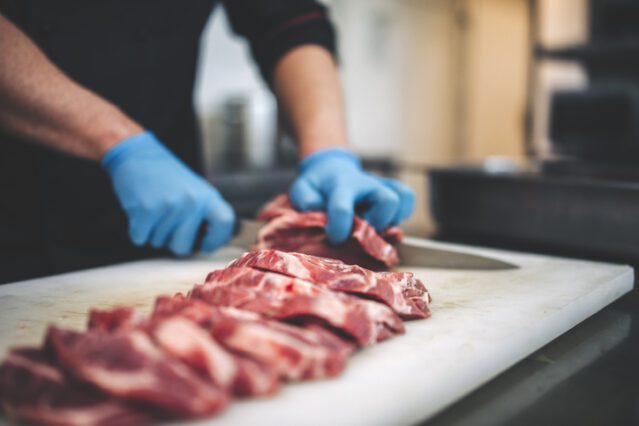On the surface, lab grown meat is a nice noble story.
Save all those poor defenseless cows from cruel factory farms and inhumane slaughterhouses. Save the environment from all those cow farts, burps, and emissions involved with animal agriculture. Handcraft meat to be healthy, nutritious, and good for the environment. Optimize the fatty acids. Eliminate the chance of animal-borne diseases or antibiotic resistant bacteria. No gross, unhygienic animal manure. No blood or guts. It’s clean, safe, clinical. We can even call it “clean meat” or “cultivated meat“.
Except it’s none of those things. So, what is it?
How is lab-grown meat made?
Lab grown meat starts by extracting stem cells from living animals. To grow “beef” in the lab, they extract cow stem cells. “Chicken,” chicken stem cells. And so on.
The cells are bathed in a growth medium—a mixture of amino acids, glucose, salts (minerals), vitamins, antioxidants, growth factors, hormones and other components necessary for cellular growth, such as buffers for controlling pH balance. The most common viable growth medium has been fetal bovine serum (extracted from pregnant cows), but some companies have developed other growth mediums that apparently don’t involve living animals.
They are placed on “scaffolding” to promote differentiation into fat, muscle, blood and other types of cells. Scaffolding can be based on gelatin, corn starch fiber, fungi, and many other substances.
It’s a really complex undertaking. It’s trying to replicate an organic process that’s constantly in flux. When this happens in an animal, there’s a base level “intelligence” to it. It just kind 0f… happens. It emerges. The lab environment cannot replicate the organic environment. That’s why in vitro studies rarely translate perfectly into in vivo studies: environment matters. Terroir matters.
They might be able to produce something that approximates a piece of beef in the lab, that looks kinda like it and tastes a little like it, but who’s to say what’s lost in translation? Could it be something important? Could it be something vital for the ultimate health effects of eating it?
The most recent one I saw was an Israeli company that managed to grow a 3.67 ounce “steak.” Look at that thing. It’s pathetic, frankly. They’re a long way off. What’s lab grown meat really about?
Lab-grown meat isn’t about health
Lab grown cultured meats are ultimately about control and money. If cultured meat replaces traditional animal husbandry, as is the stated goal, the ability to provide animal protein becomes an intellectual property controlled by the few and the powerful. It becomes an asset, an industry, a technology. Two of the biggest funders of lab grown meat include Tyson and Cargill, some of the largest meat producers in the world. Are they doing it out of the goodness of their hearts or to exert even more control over the ability to produce meat?
What will end up happening is the conversion of one of the most ancient and democratic human technologies—animal husbandry—into a patentable, intellectual property. Previously, if a family had a few goats or a milk cow, they were set. They might not be rich, but they could produce their own food (and sell it at market if they desired). Having animals was freedom and wealth. In fact, some of the most ancient words for wealth or money stem from the word for cattle or livestock. For example, the Latin pecunia (money) derived from the word pecus (cattle).
Plus, animal foods are highly mobile and energy dense. The Indo-European expansions that shaped the course of Europe, South Asia, and Central Asia for millennia to come were made possible by animal husbandry and the mobile milk, meat, and blood it provided. Small but potent bands of nomadic pastoralists swept across grasslands with their horses and herds, laying waste to the sedentary settlements of grain-eating, Neolithic farmers, all because their sustenance was on the hoof. Supply chain? They were the supply chain.
Were those expansions violent and ugly? Of course. That’s history. But the point is that animal foods confer great power. Traditional ways of producing animal foods spread the power and democratize it. You don’t have to be a huge multinational corporation; you can be a homesteader, or a subsistence farmer in a developing country, or a member of a CSA. Or just a consumer at a farmer’s market.
Lab grown cultured animal foods promise to concentrate the power. If meat becomes an intellectual property, someone will own that IP. Someone will own the ability to provide animal protein, and the traditional ways of animal husbandry will be crowded out, regulated out.
Difference between industrial lab meat and other industrial foods
Although I make mayo in a big factory, you can still make your own mayo at home. Nothing’s stopping you. Get a whisk, some oil, a few yolks, some vinegar, and you can do it.
If lab grown meat replaces traditional animal husbandry, you won’t have any options other than buying it. No one but the owners of these companies will have the money to afford the equipment and bypass the regulations. There won’t be backyard lab grown meat. In the proposed lab meat utopia. Instead there’d be 4 or 5 companies controlling the “meat” industry. The technological, financial, and regulatory hurdles to become a lab meat producer would be astronomical.
It’s not a perfect world now by any means, but you can still hit up Craigslist in any town in the United States and find someone willing to sell you a quarter cow within 50 miles. There are hundreds of thousands of beef producers, some large, some small. That would change.
How clean is lab-grown meat?
“Growing” muscle cells creates byproducts, metabolites, many of them toxic. In normal growing animals, these toxins are disposed of in the urine and feces so they don’t concentrate in the tissues and cells themselves. How do lab meats dispose of these toxins? How do they avoid concentration in the very same tissues they’ll be selling as steaks and roasts?
Animals have immune systems to fight bacteria, viruses, fungus. They’re not perfect by any means—that’s why we turn to antibiotics and antiparasitics—but they mount a pretty strong defense. It wouldn’t be pretty without an immune system. Lab meats don’t have immune systems. They’re just cells sitting in a vat.
So what happens in the lab? These are honest questions. Maybe they have answers, but I haven’t seen any.
Can meat really be optimized?
One of the “features” of lab grown meat is that producers can micromanage the nutrient, fatty acid, and vitamin content of their product. They can “optimize” it to be healthier.
If lab grown meat allows producers to micromanage the fatty acid and nutrient content of their product to be healthier, whose idea of “healthy” do you think they’ll follow? Will they follow ancestral health guidelines or USDA guidelines? Just imagine the damage they can do:
- Removing all saturated fat, replacing it with polyunsaturated fat.
- Canola stem cells interspersed with cow stem cells to promote “healthier” fat.
- Infusing the meat with statins.
- Replacing the gelatin in meat with “fiber” to lower your cholesterol.
- Eliminating the heme iron from all cultured red meat.
By most official “expert” accounts, these would all be improvements on traditional red meat. But they would be complete disasters.
The ick factor
I can’t quantify the ick factor. There’s no real science “justifying” it. But it’s there, and it’s likely there for a reason. At least that’s my bias: that instinctual urges and inclinations have evolutionary purposes that we just have to discover. Sometimes we figure out what the purpose was and it no longer applies. Sometimes we figure out the purpose and find that it does.
But you can’t deny that it feels really weird to grow meat in labs. Maybe it doesn’t feel that way to everyone, but it happens in enough people to be notable. We should probably respect that instinct.
If lab grown meat were always just a small oddity, a niche product that people could choose to indulge in, it wouldn’t be a problem. But there are billions of dollars devoted to the industry with the express goal to replace traditional animal agriculture. There’s no compromise allowed here—they don’t want you eating regular meat anymore, they want a “meat-free future”—and I urge you to reject lab meat with your heart, mind, and wallet.
Take care, everyone. I’d love to hear what you think about lab grown meat down below.
About the Author
Mark Sisson is the founder of Mark’s Daily Apple, godfather to the Primal food and lifestyle movement, and the New York Times bestselling author of The Keto Reset Diet. His latest book is Keto for Life, where he discusses how he combines the keto diet with a Primal lifestyle for optimal health and longevity. Mark is the author of numerous other books as well, including The Primal Blueprint, which was credited with turbocharging the growth of the primal/paleo movement back in 2009. After spending three decades researching and educating folks on why food is the key component to achieving and maintaining optimal wellness, Mark launched Primal Kitchen, a real-food company that creates Primal/paleo, keto, and Whole30-friendly kitchen staples.
Post navigation
If you’d like to add an avatar to all of your comments click here!
Source by www.marksdailyapple.com



